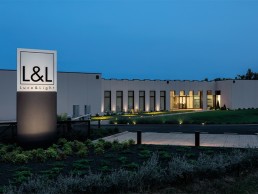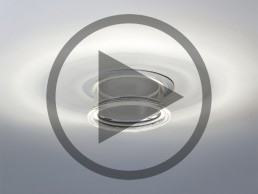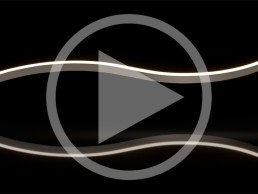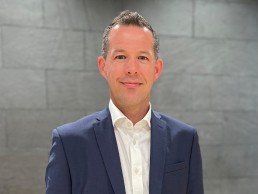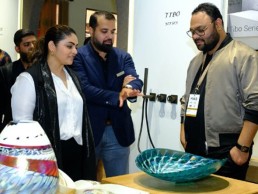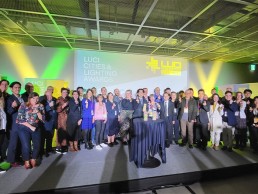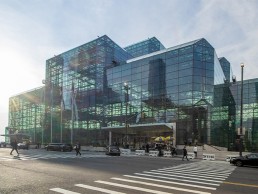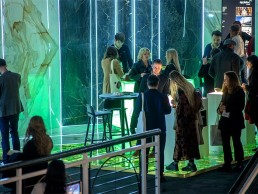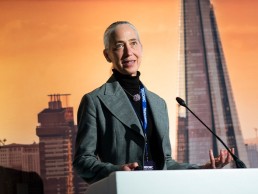LiGHT 22 – inaugural show hailed a massive success
(UK) – Held over two days at the Business Design Centre, the first-ever LiGHT exhibition closed its doors earlier this week to a buzz of positivity, from both visitors and exhibitors alike.
The design community came out in force to support the new show, with over 3,000 visitors passing through the doors to see more than 100 high-end international lighting brands present their latest product ranges for the architectural and decorative specification market.
Show highlights included the [d]arc thoughts talks programme, in collaboration with lighting control specialist Lutron, which benefited from a steady stream of guests across the two days, keen to learn more about the hot topics in lighting.
With every talk well attended, the headline panel saw more than 250 people crowd round the stage to see Masters of Light(ing) designers Sally Storey (Lighting Design International); Mark Major (Speirs Major); and Nick Hoggett (dpa lighting consultants) take to the stage to share their knowledge and expertise with the industry.
Visitors to the show also made good use of the dedicated workspace area on the gallery level. Illuminated by table lamps from British lighting brand Tala, LiGHT Work was a beautiful, relaxing space allowing show attendees to complete office tasks, while offering dedicated wi-fi, free coffee, and charging points.
Day one closed with a late-night drinks party hosted by the organisers [d]arc media and stand parties throughout the space.
The buzz around the new lighting event continued into day two with a LiGHT networking lunch hosted in the [d]arc thoughts talks arena, allowing visiting designers and manufacturers to meet in a relaxed space, while taking in a video interview with internationally celebrated product designer Michael Anastassiades.
The show was also heavily supported by industry trade bodies and organisations including: SLL; IALD; ILP; LIA; BIID; SBID; Women in Lighting, along with industry media organisations: ICON; On Office; Archiproducts; DeZeen; NLA; World Architecture News; and STIR.
Delighted with the success of the first year, [d]arc media Managing Director, Paul James said: “The show has been a resounding success with the design community coming out in force to support this first year. LiGHT 22 caters to the ever-growing design sector in London and further afield and is a new offering for lighting design built on [d]arc media’s knowledge and experience of the lighting specification market that spans more than 20 years.
“We have had nothing but positive feedback from exhibiting brands and visitors alike and I am really looking forward to what next year’s show will bring.”
Free to attend, dates for next year’s show are confirmed as 21 & 22 November 2023.
New Nulty appointment announced
(UK) – Nulty has recruited Charlotte Croft as Business Development Manager for Europe. Croft brings over 13 years’ experience in technical sales and lighting design to the role, having previously held positions at Whitecroft Lighting and Fagerhult Belysning.
Croft’s appointment comes at a key time for the London studio as Nulty looks to expand its project scope in the UK and beyond. Her remit will be to develop client relationships across all sectors and spearhead practice-to-practice meetings, CPD presentations and networking at industry events.
Paul Nulty, Founder, Nulty commented: “Charlotte is a very welcome addition to the Nulty team. Her friendly personality, industry knowledge and project management skills are exactly what we need to build successful partnerships with clients. Whilst we are expanding quickly with new studios in Pune and Bangkok, London remains an important market for us and is home to a huge number of global architecture and design practices, project management firms and leading developers. Her appointment signals our intent to cultivate these relationships and undertake exciting new work for the studio.”
Charlotte Croft, Business Development Manager, Nulty added: “I’m thrilled to join a company that I have long admired for delivering industry-leading lighting design. I’m looking forward to working closely with the design team to grow the company’s pipeline of work and build on the great results that have been achieved so far.”
L&L Luce&Light celebrates 15th anniversary
(Italy) – L&L Luce&Light has commemorated its 15th anniversary with the inauguration of its new headquarters in Dueville, in the province of Vicenza, Italy.
The large, modern space, the new office is better suited to the company’s current size, and as well as providing welcoming, efficient workspaces, offices and leisure areas for staff, it is an ideal venue for product tests and meetings with lighting professionals. In the showroom space, light is used to define each zone and their different functions. The space is divided into four zones – lounge area, test area, meeting area, and camera obscura.
Alongside the new premises, the Italian manufacturer has celebrated its 15th anniversary with certification of ISO 9001 – the international standard that assesses corporate quality management systems, and in recent years it has become a strategic choice for companies looking to be more competitive in the market.
“The recognition comes at a perfect time for L&L Luce&Light, at a stage of company maturity where we can guarantee the total commitment that certification brings with it,” a statement from the brand said. “It is a confirmation of a search for quality and continuous improvement – planning, executing, controlling, correcting this process several times, at all levels and in all areas of the organisation.”
Sylvania: Concord Equinox

Revolutionise architectural lighting with Concord Equinox, the innovative new vision of downlight from Sylvania Lighting.
Using QuarkStar’s award-winning system of light refraction, Concord Equinox provides functional downlighting with simultaneous upper lighting. This creates a halo backlight which improves the ambience and illuminates spaces in a beautiful way. The SylSmart Standalone version allows programming with a touch of a button using Sylvania’s smart lighting management system.
LightLine - Light that Connects
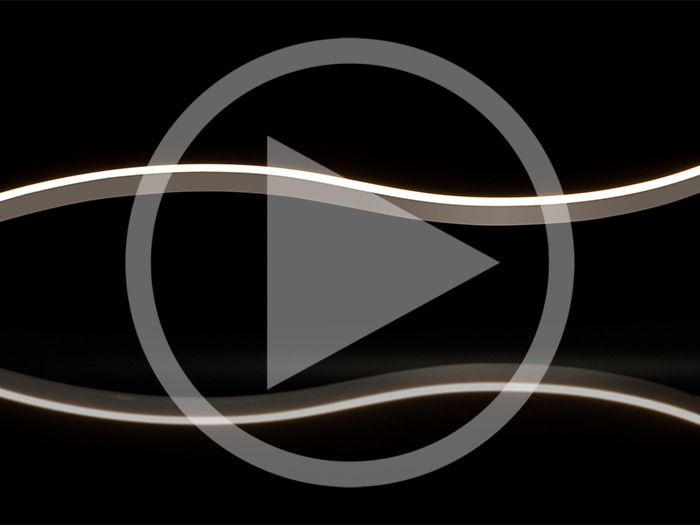
The LightLine can be used in many ways, whether to skilfully highlight façade contours, to add value to courtyards, public spaces or to set beautiful accents indoors. It is truly customizable, whether it is the length to the millimetre, the colour temperature or the way of mounting. The light line adapts to your design concept, giving you even more creative freedom in designing your project.
New Managing Director UK & Ireland at Zumtobel Group
Zumtobel Group has announced the appointment of Paul Kilburn as its new Managing Director, UK & Ireland.
Kilburn will report to Marc-André Rusch, Vice President Region West & South Europe. Rusch commented: "Paul will drive the UK Commercial business to achieve its goals and support its teams to deliver an outstanding experience to our internal and external customers. We look forward to a successful cooperation and wish Paul a good start at Zumtobel Group."
With more than thirty years of experience in the Electrical Building Product Industry, Kilburn joins Zumtobel Group from Volution Group Plc, a FTSE250 company and manufacturer of Ventilation products. During his eighteen years with the Group, Kilburn held several senior positions, including seven years as Managing Director.
He commented: “I am thrilled to be joining the Zumtobel Group at a moment where the UK and Ireland are poised for further growth. The Zumtobel Group brands, Thorn and Zumtobel, are renowned in the industry. It will be an honour to work with its talented teams as we get set to make an even bigger impact.”
FOAID Mumbai celebrates art, architecture and design
(India) – Held on 7-8 October, the 9th edition of FOAID (Festival of Architecture and Interior Designing) Mumbai brought together the biggest stalwarts of the Indian design fraternity for an array of stories, design journeys and discussions in a confluence of art, architecture, and design.
With numerous presentations by Rizvi Hassan - Winner, Aga Khan Award for Architecture 2022, Dipen Gada, George Seemon of Stapati, and an engaging discussion on the topic ‘Reclaiming Public Spaces in India: Strategies & Projects’ with esteemed panel members including Naresh V Narasimhan (Moderator), Habeeb Khan, Hiten Sethi, Rinka D'Monte, Biju Kuriakose, Arjun Malik, Salil Ranadive, Vivek Gupta, Zameer Basrai, Mansi Sahu, the conference invited architects and designers from across the country.
Partnered with Classic Marble Company, the Design Manthan conference was seen as an avenue through which to witness the multiplicity of voices, and to discuss thought-provoking ideas through panel discussions, presentations, talks and debates, bringing together some of the most creative minds of the architecture and design fraternity.
In the Design Arena was an exhibit of more than 200 inspirational works, comprising built and ongoing projects, the collective display highlighting major architectural projects of the design world.
Elsewhere, the Creative Minds Next was a progressive platform, intended to award senior, experienced design professionals in ongoing projects, while the Merino Architecture Ideas was an annual, national competition crafted to recognise the excellent works of next-gen designers.
FOAID also hosted Expressions, an art installation competition, with an exhibition showcasing remarkable art pieces made by students on the theme ‘Scale in Architecture’.
Over the years, FOAID has proved to be a splendid platform for expressing and exchanging thoughts in the field of design, and engaging with the design community.
Following FOAID Mumbai, the New Delhi edition will be held at the NSIC Grounds, Okhla New Delhi on 25-27 November.
New Head of Light Bureau announced
(Sweden) – Fredrik Hellberg has been named as the new Head of Light Bureau, the company has announced.
An experienced business leader with a deep knowledge in sales and understanding client needs, Hellberg has previous experience from being part of the management team at Sweden-based architect firm Koncept – another design brand in the AFRY portfolio.
Hellberg spent 10 years at Koncept, leading big projects and creating value through good design, among which were several projects with Light Bureau. He will take on the new role on 7 November, leading a team of around 80 lighting designers and engineers across Scandinavia and the UK.
At the same time, Light Bureau is strengthening its international business with Paul Traynor leading international business development. Traynor will continue as Country Manager in the UK and drive Light Bureau’s international presence to become an even stronger competitor on the global market.
“I am happy to see Fredrik return to AFRY in this new capacity,” said Helena Paulsson, VP and Head of the Architecture and Design offer at AFRY. “His experience within leadership and business development will be the perfect fit for Light Bureau.
“I would also like to thank Paul Traynor, who has done a fantastic job of heading Light Bureau through a demanding two years, and I am confident that he will successfully continue leading growth in existing as well as international markets.”
Hellberg added: “I have always been impressed by Light Bureau, home of some of the most skilled individuals in a relatively young, developing industry, and I look forward to working with the best.”
Winners of LUCI Cities & Lighting Awards revealed
(South Korea) – In a ceremony held on 21 October in Busan, South Korea, where the 20th anniversary of the LUCI Association was celebrated, the winners of the inaugural LUCI Cities & Lighting Awards winners have been announced.
Designed for cities and local authorities, the LUCI Cities & Lighting Awards was created to recognise urban lighting projects that reflect the multi-disciplinary nature of urban lighting and show a positive impact on economic, social and cultural development. Held every two years, the awards celebrate cities that have driven projects with the ultimate aim to improve sustainability and quality of life.
The jury for the awards included six distinguished urban lighting professionals: Kristin Bredal, Founder, CEO and Chief Designer of Zenisk; Jean-Michel Deleuil, urban planning professor at the National Institute of Applied Sciences (INSA Lyon); Elisa Hillgen, lighting designer and City of Light coordinator for the City of Jyväskylä; Vincent Laganier, founder and editor of Light ZOOM Lumiere; Keonsoo Nam, Director of Public Urban Design Division for the Busan Metropolitan City; and Esther Torelló, founder of Lightecture Magazine.
Together, they analysed 20 entries received by LUCI from 14 countries. LUCI Cities & Lighting Awards Jury President Vincent Laganier said: “At the heart of the energy crisis, the LUCI Cities & Lighting Awards come just at the right time. This new award highlights quality of life and the environmental dimension through urban lighting.
“Designated by the 2022 Jury, our winners represent this ambivalence of light: how to bring life to the city at night, while at the same time taking care of all the usage, from citizens to visitors? Congratulations for this excellent initiative by the international association of cities of lights.”
The third place winner was Seoul Metropolitan Government, South Korea, for the New Gwanghwamun Square Lighting. The jury valued the transformation of the historic New Gwanghwamun Square with a high traffic density into a harmonious and calm nightscape for the use and enjoyment of its citizens.
“The transformation of this place has been executed with care for history, culture, and place. Attention is pulled towards a multi-layered series of experiences and meeting places,” said the judges. “It is a combination of calm, low scale and stylish lighting. The area has a big meaning for the citizens and visitors.”
In second place was the City of Tampere, Finland, for the Tammerkoski Rapids – Industrial Heritage Reimagined project. Here, the jury recognized the way that lighting makes the history of the city visible during nighttime in a project that values the industrial buildings along the rapids, as well as the historical landmarks, creating a fascinating interplay of light and shadow.
The judges continued: “The project shows excellent and precise lighting of the industrial historical place. It is well planned and well executed letting the beautiful buildings present themselves. All with full control systems that enables adjustments in light levels throughout the seasons and the night.”
The winning project was the City of Izmir, Turkey for the Konak-Kemeralti Lighting Masterplan. Started in 2016, the two-phased masterplan aims to integrate social, ecological, and economical aspects of planning into the process of creating a sustainable future for the city. Although converting to LED reduced energy consumption and carbon emissions, the more important objective of the plan was to create a “dialogue” with light.
The jury added: “The jury commented that this lighting master plan integrates social, ecological, and economic aspects. It improves the safety of public spaces while achieving 50% energy savings and reducing the carbon footprint.
“An ambitious approach that combines a global vision of urban spaces and a sensitive consideration of everyday living spaces.
“This project shows how thoughtful lighting is an important part of the social glue that makes us see, meet, experience, and interact. A need that all humans have everywhere.”
Mark Burton-Page, LUCI General Director added: “All these fantastic projects will be highlighted within LUCI’s communication channels and events in the next years. They enrich the long-term collective knowledge sharing process that cities have successfully engaged in at a world level, within LUCI for the past 20 years. We are already looking forward to launching the second edition of the Cities & Lighting Awards, planned for 2024.”
LightFair to move to biennial event schedule
(USA) – LightFair, North America’s largest architectural and commercial lighting trade show and conference, is transitioning to a biennial event schedule, organisers have announced.
Commencing with the 2023 event, scheduled for 21-25 May at the Jacob K. Javits Convention Center in New York, the updated schedule will, according to organisers, “better serve the industry’s manufacturing cycle, product marketplace and the overall needs of lighting professionals”.
Dan Darby, Show Director, said: “The lighting industry has been shifting and we took an opportunity to reflect on what we offer and optimise our event in a way that better aligns with industry needs.
“We’ve heard and felt the path of the industry moving and it’s important that we evolve with it. LightFair always has the best interest of our robust community of lighting professionals in mind, and we are excited for its brighter biennial future.”
The schedule change comes as part of an overarching strategic plan, developed by LightFair’s management committee in response to the changing needs of lighting manufacturers and specification. The plan includes new features for 2023, such as partnerships with NYCxDESIGN and ICFF, immersive lighting installations, learning tours, audience expansion to include residential lighting professionals and more.
The new biennial programme will run on a frequency that aligns with every-other-year manufacturing cycles. With the shift, LightFair is expecting to see an increase in attendance from all segments of the industry, providing further business opportunities for lighting designers, distributors, engineers and architects.
“As one of the owners of LightFair, the IALD is excited to embrace this new biennial cadence that we know will best serve our community in the years to come,” said Christopher Knowlton, IALD CEO. “LightFair is evolving, and we encourage our members to join us on this sensational journey.”
IES Executive Director Colleen Harper added: “The Illuminating Engineering Society remains committed to its mission to improve the lit environment by bringing together those with lighting knowledge and by translating that knowledge into actions that benefit the public. With this transformation, LightFair will continue to be a mainstay of the lighting industry, allowing us to work together as a community to connect, engage and inspire.”
Countdown begins for Surface Design Show 2023
(UK) – Surface Design Show is gearing up for next year’s edition, which is held from 7-9 February 2023, once again showcasing the best in material innovation. A well-established part of the design calendar for nearly 20 years, the show returns to London’s Business Design Centre in just over 100 days. It provides the perfect opportunity for material experts, and the architectural and design community to come together under one roof.
Visitors to Surface Design Show 2023 will be inspired by new product launches running the gamut of colour, materiality and sustainability, plus diverse displays of surface-based installations and a comprehensive speaker programme featuring accomplished industry professionals, passionate about the future of surface design.
Surface Design Show has already welcomed more than 130 exhibitors to participate. These include Red Dog Glass Design which produces beautiful glass splashbacks; Applelec which specialises in signage, display and lighting and celebrates 25 years in business in 2023 and contemporary metalworking company Novocastrian.
Located right in the heart of the exhibition, Surface Design Show welcomes back Surface Spotlight Live (SSL), an area which gives visitors a chance to touch and compare the latest material prototypes. Centred around this year’s theme, ‘Shaping Communities’, SSL will highlight the importance of new exchanges between surfaces, people and environments. From material transformation to inclusive design, co-creation to sensory wellbeing, SSL will present designs creating thoughtful solutions for interiors and architecture. This section of the show will again be curated by leading trend and colour expert, Sally Angharad.
The talks programme is always a particular highlight of Surface Design Show. The Main Stage, designed by Emily Skinner of recycling pioneers Smile Plastics, will host 18 different presentations and feature more than 40 speakers, inspiring a professional audience of architects and designers.
Setting the tone for the live events programme will be the Opening Night Debate, hosted this year by Jonathan Smales, executive chairman with Human Nature, a leading proponent of sustainable development. The debate, which has CDUK as the official partner, will question how architecture and interior design professions are dealing with the Show’s theme of Shaping Communities.
Over the two and a half days, the Main Stage will host a range of debates, panels, trend forecasts and insights into the latest surface design innovations. It will also be the venue for the Legends Live series of ‘in conversations’ in partnership with Mix Interiors, where industry leaders interview someone they admire.
The PechaKucha evening also returns for 2023 having previously been an entertaining talking point of Surface Design Show. This fast and furious speaking format sees eight speakers battling to get their message across, presenting 20 slides for just 20-seconds each. The evening will be hosted by Nicola Osborn, creative director of design studio Basha-Franklin.
Another popular element of the show is the Surface Design Awards. Now in their 11th year, they continue to set a benchmark for architectural and design achievements across the world. More than 110 projects were entered into the 2023 Surface Design Awards, coming from an impressive 24 different countries. The BAFTA Headquarters in London by Benedetti Architects, which scooped the Supreme Winner award in 2022 set the standard for excellence in surface design. Following the success of its debut last year, the Architectural Photography category returns once more for 2023.
This year the Awards’ judging panel is co-chaired by Jonathan Hagos, Director of architecture studio Freehaus and Nasim Koerting Head of Design at The Office Group, and features a diverse mix of industry professionals who have made a name for themselves amongst their peers.
Tridonic industry event a huge success
(UK) - Tridonic recently hosted a successful and well-attended event; ‘Making Light Work for Business, Buildings and People’. Held at the Business Design Centre in London, almost two hundred attendees joined Tridonic and a host of guest speakers to take advantage of the learning opportunities, keynote speeches and networking.
The event was a day of two halves, with the morning session focusing on the outdoors, ‘Light when and where it is needed’. The session addressed the infrastructure required to enable Smart Cities, including integrated outdoor lighting solutions and how smart street lighting is helping to unlock tomorrow’s cities. The morning concluded with thoughts on how to bring indoor and outdoor lighting together in one single integrated network, ready for the afternoon’s session focusing on the indoors and workspace management.
The afternoon session focussed on a number of the major challenges facing building owners and operators including Health and wellbeing, net-zero carbon and building compliance. The agenda brought a spotlight on Tridonic’s ecosystem of partners, who all play a key role in delivering real business value, a true example of this being the exemplar case study shared on the DL/78 project in Charlotte Street.
The day coincided with the announcement from Tridonic that it is the first company in the electronics sector globally to be Cradle to Cradle Certified.
Keynote addresses were delivered by key industry figures throughout the course of the day including Dr Shelley James, Consultant, Curator and WELL Advisor; Tom Spilsted of Construo; Stephen Jackson of Casambi; Richard Perry of Lucy Zodian and Alison Gallagher from Arup. Richard Strode, Simon Blazey and Johann Hofer from the senior team of Tridonic led the event with talks from Markus Wagenseil, Matt Caygill and Martin Thompson from the wider Tridonic team also.
Adding to the appeal of the day, a ‘Partner’s Marketplace’ was set up as the centralised networking area. This offered attendees the opportunity to preview solutions and services that could benefit their work. Partners included Binary Forge, Casambi, Construo, Holders Technology, and Lucy Zodian, who all had space within the marketplace. An area that strongly demonstrated how the ecosystem of partners collaborate to ensure success not only historically, but also as we move forward with an ever-changing landscape.
A session was held prior to the opening of the event for the media, to offer a preview into the Tridonic Building Asset 360 solution. The event concluded with an open panel discussion, allowing attendees the opportunity to ask questions to the panel of speakers.
Richard Strode, Managing Director of Tridonic UK said: “The Making Light Work event was a great success, with an impressive number of attendees and incredibly positive feedback. We are very appreciative to all our speakers, who gave compelling keynote addresses, covering a range of expert topics. We also extend sincere thanks to our ecosystem of partners, who contribute to our continued success.”
Simon Blazey, Strategic Solutions Sales Manager of Tridonic UK, added: “Seeing so many peers from across the industry was fantastic. The event was so beneficial for attendees, from learning about new solutions to listening to expert talks, everyone took something away from the day. We’re looking forward to organising more events in the future.”
For those who were unable to attend the day in person, Tridonic are currently putting together a webinar which will encompass all of the key insights and takeaways from the event.




